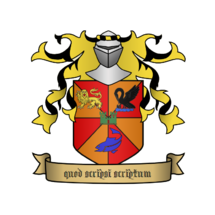Rino Island Constitution (2014)
| Constitution of the Republic of Rino Island | |
 Coat of Arms of Rino Island
| |
| Created | 20 May 2014 |
| Ratified | 20 June 2014 |
| Location | Rino Island |
| Authors | President Benedetto Samperi as Author Anastasio López as Revisor |
| Signers | President Benedetto Samperias President of Rino Island |
The Political Constitution of Rino Island is the highest rule in the Republic of Rino Island. It is the second constitution of the micronation, and was officially promulgated on June 20 of 2014 by President Benedetto Samperi, who was its main editor. It follows the guidelines of neoconstitutionalism, receiving various influences; mainly those of the Chilean constitutions of 1833 and 1925, as well as the Fundamental Law of Bonn.
The constitution ratified the role of the President of the Republic as the Head of State and Government, following the Chilean constitutional tradition. He also maintained the Great Senate, with ten members, of which the majority are elected on lists proportional to the vote of the parties. From the Constitution of Italy the idea was obtained that a number of senators were appointed by the president and institutions, for greater representation.
The inspirations for the Constitution come from different sources. Mainly from the 1833 Constitution of Chile, as well as the 1925 Constitution of Chile. Part of its regulation also considered the Fundamental Law of Bonn (in the prohibition of Nazism and totalitarian groups) and of the Italian Republic (organic representation of the legislative power).
History
In 2013 Rino Island went through a serious social and moral crisis due to the massive entry of citizens via the web, many of radical ideologies, which were not part of the original project. Due to this, Vittorio Rino left the presidency to his friend Benedetto Samperi, with the mandate to write a new constitution that adapted the republic to the new times. In May 2014, Samperi a new constitution to replace the Rino Island Constitution of 2010. The new constitution was approved by decree of the President of the Republic. It was the object of massive popular support and acceptance.
The first government of Tomás Ríos carried out a constitutional reform, lowering certain quorums and modifying some rights. In September 2015 Ríos suspended the validity of the constitution, regaining its validity in January 2016, after a frustrated reform attempt rejected by the population.
It was suspended in August 2016 by the governing board, and that suspension was terminated by the second government of Tomás Ríos, which also made modifications to it. Francisco Gómez tried to draft a new "anti-fascist" constitution, but made no effort to do so.
In 2017, after the national uprising in May, it was fully reestablished. Some institutions had provisional application, but by 2018 it had fully recovered its validity. The government of Anastasio López, in 2017, reversed all the modifications to the constitution, returning to the existing text as of March 2015. It had an important modification in 2020, which included a bill of citizens' rights, an economic and labor statute, and which extended the presidential term to two years, and with re-election.
Features of the Constitution
The Constitution is made up of 10 chapters and 49 articles, numbered with Roman numerals. The prominent features of the constitution were:
- A unitary state under strong leadership from the President of the Republic.
- Great unicameral Senate, with members elected and appointed by the President of the Republic and institutions.
- Establish the Catholic, Apostolic and Roman religion as the official one of the state The constitution limited the presidential term to one year, without re-election
- Powers of legislative initiative to the president.
- It created an independent supreme court in charge of the administration of justice.
- Creation of a National Trade Union Center, which would represent the country's workers, both before the president and in the Great Senate.
Constitutional Laws
The fundamental rights of citizens are regulated in the "Rinoislanders Bill of Rights", while the economic system is regulated in the "Economic Statute" and the " Labor Charter ", both special laws of constitutional rank. The regulation of the Grand Senate of Rino Island, the national emblems, and the Rinoislandic National Unity Party and political parties in general are also the subject of laws of constitutional rank.